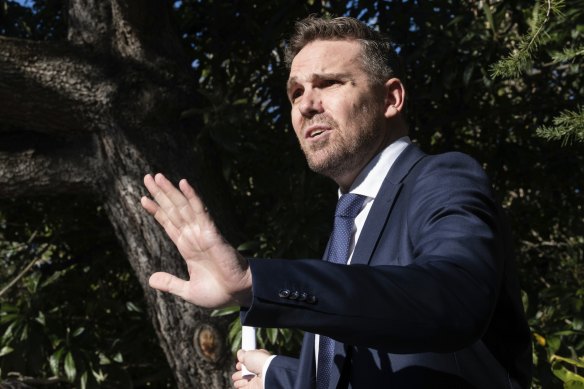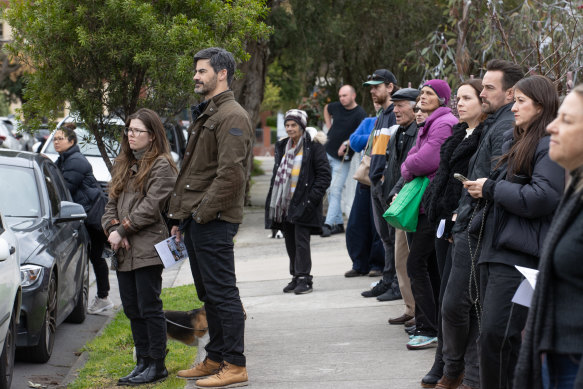How years of higher rates helped the most affordable properties outpace the top end
By Jim Malo and Tawar Razaghi
Home buyers are turning to more affordable properties after two years of higher interest rates slashed the amount of money they could borrow.
The strong demand has been pushing up prices for cheaper properties at a faster pace compared to more expensive homes.
The bottom quartile of the market across Australian capitals grew 3.3 per cent over the past three months, CoreLogic data reveals. It easily outpaced the top quartile of properties over the same period, which grew 0.8 per cent.
The Reserve Bank on Tuesday held the cash rate at 4.35 per cent. The board indicated that inflation was persistently high and did not rule in or out further rate rises.
CoreLogic’s executive research director Tim Lawless said the most affordable properties were rising in price as buyers chased affordability, with the expectation interest rates could be higher for longer.
“Every capital city is recording stronger conditions across the lower quartile except for Darwin and Canberra; they are the two most affordable markets,” Lawless said. “They don’t have the affordability pressures that are pushing demand to the lower quartiles. Every other capital city is definitely seeing this trend.”

Experts says high unaffordability was leading to lower growth in the top end of the market. Credit: Rhett Wyman
He said there was an increasing divergence in the rate of price growth between expensive and more affordable properties, including stronger performance in the unit sector.
“As we’ve seen affordability becoming more challenging and interest rates rise further we’ve seen this migration of stronger growth conditions across the lower quartile,” Lawless said.
“It’s a deflection of demand from the more expensive price points to the lower and middle end of the markets.”
Westpac senior economist Matthew Hassan said the effect was noticeable in most capital cities in the country.
“The performance in lower tier markets is particularly striking in Brisbane, Adelaide and Perth,” he said. “It’s not just the high rate environment and stretched affordability, it’s also a byproduct of low levels of stock on the market.”
Hassan said the slowing of the top end could indicate affordability was hitting a hard limit, and that prices were approaching a peak.
“It’s actually quite unusual. In the past, the top end will lead the cycle. It could mean the cycle is starting to run out of fuel,” he said. “Maybe there are a few other things at play as well … We’re running out of places for buyers to go.
“The only places with pockets of affordability are undesirable markets like units.”

Buyers were turning to cheaper homes out of necessity. Credit: Simon Schluter
Lawless said the cost-of-living crisis was weighing on demand on several fronts, compounding the difficulties of buying a home.
“We’ve also seen it’s become harder to save for a deposit because the cost of living expenses are as high as they are as well as rental expenses.
“A lot of first home buyers will find it hard to save when rental costs are this extreme.”
Hassan said the ubiquity of the bank of mum and dad in the housing market indicated affordability was becoming increasingly stretched.
“We know the bank of mum and dad has been a more prominent source of funding … I suspect it’s now becoming a prerequisite in some of the smaller capital cities’ markets as well,” he said.
Equilibria Finance managing director Anthony Landahl said committed buyers were turning to purchasing a property in cheaper markets, even if they didn’t want to live there, to get a toehold in the property market.
“People who might have traditionally bought a home are investing in a cheaper area and renting where they want to live,” he said.
Landahl said this could also help to explain the higher-than-normal growth in the bottom quartile.
“The data’s pointing towards that, were seeing that in most capital and regional cities, the lower quartile is attracting buyers,” he said.
Price growth in the more affordable end of the market would begin to lose steam if rates continue to rise, as it would become unattainable for even middle income earners, Lawless said.
But rates cut would boost borrowing capacity and sentiment, he said.
“It probably means we can see renewed price growth. The underlying affordability pressures are still going to be there … The undersupply of housing is a key factor of propping up property prices.”
He noted rate cuts could help drive supply as economic conditions become more conducive to build again.
Hassan was more bearish on the prospect of price hikes once rates were cut. Given the market was already growing out of step with the rates cycle, he thought the effect could be muted.
“If and when we see rates move lower we think it will be a slow and gradual process and won’t free up much affordability,” he said. “It’s been an unusual price cycle already … it’s front-loaded a lot of potential price appreciation.”